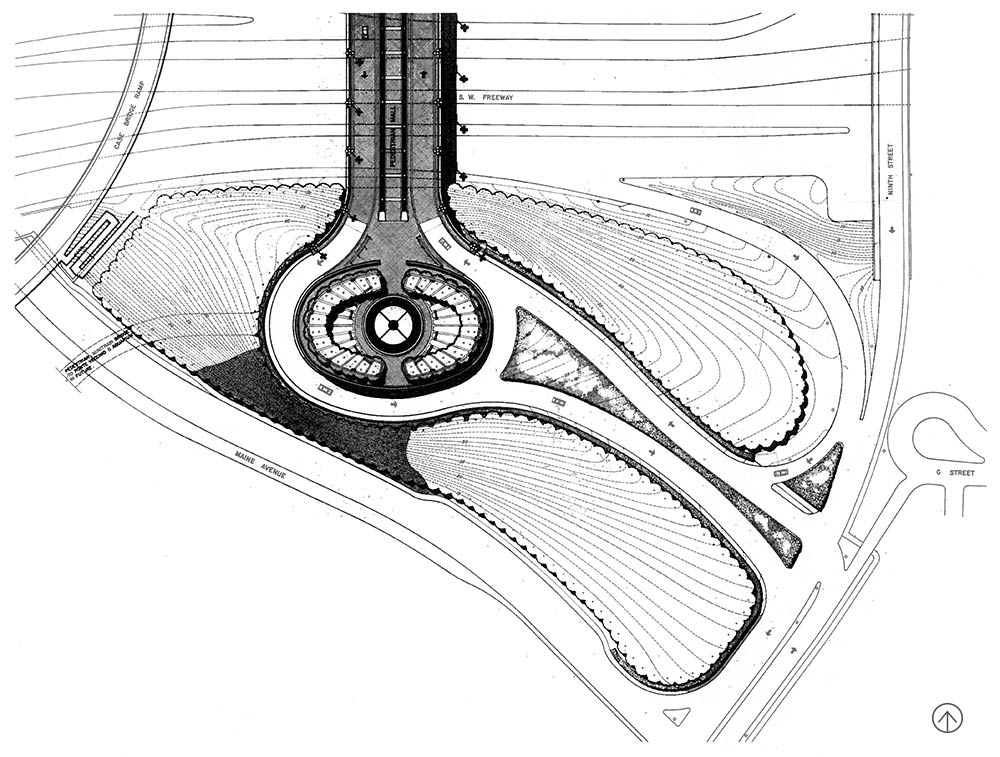-
Benjamin Banneker Park (also known as the Tenth Street Overlook) is the terminus of Washington DC’s Tenth Street Mall, the central thoroughfare that connects the Smithsonian Institution’s Smithson Castle to the Southwest DC waterfront. The Mall runs through L’Enfant Plaza, a brutalist complex of concrete commercial and office buildings, designed by the firm of Webb & Knapp. I.M. Pei, then an architect with the firm, created the master plan for the development, a 20-acre complex created as part of the Southwest DC urban renewal project.
.jpg)
The Office of Dan Kiley was commissioned to design the 4.7-acre ovoid park, set within an eight-acre landscape, which former Kiley colleague Roger Osbaldeston described as a, “design challenge … a complete abstract form with ever-changing slopes, contours and site boundaries.” Unlike, many of Kiley’s other designs, which allowed for the creation of multiple layers of experience, the parameters of the small site placed limitations on the design team. As Kiley noted, “The Overlook differs from my other projects at the time in that it lacks layers of organizational devices as well as the interplay of varying scales, two methods used to elicit a sense of open-ended spatial flow. The design is simply a point at the end of a line, a succinct response to its location and program.”
Kiley’s design is a small concave plaza bounded by a circular roadway. The centerpiece of the plaza is a large conical fountain that projects water more than thirty feet high and catches it in a circular basin made from honed green granite. The design for the fountain was based on a similar square-shaped fountain that Kiley designed for his now demolished landscape at Philadelphia’s Independence Mall. The concentric rings of fountain and basin in the center of the site are reiterated in the benches, double rows of London plane trees, and low concrete walls that establish the plaza’s edge. The plaza is paved with granite squares, a continuation of the Tenth Street Mall’s materials.
.jpg)
Osbaldeston said of the planting plan: “A double row of London plane trees were trimmed to create a wall of foliage above eye level reflecting the elliptical forms of the walls and paving patterns.” A break in the groves provides a view out towards the Potomac River and Southwest Waterfront. A grass embankment slopes down below the concrete wall to the edge of the encircling roadway. Lighting was provided for both the fountain and the trees, with the intention of making the park visible at night. Beneath the plane trees, which ring the fountain, simple granite benches provide a place for visitors to sit and watch the waterworks.
The park, which is managed by the National Park Service, officially opened on November 1, 1971, and is named in honor of Benjamin Banneker, an African American mathematician, astronomer, farmer and almanac author who helped survey the original boundaries of the capital city in 1791-1792. At present the site has fallen into disrepair due to lack of maintenance. In addition, a plan released by the National Capital Planning Commission in January 2013 proposes to significantly alter Kiley’s work as part of a larger development scheme.
1 Kiley, Dan and Jane Amidon, Dan Kiley: The Complete Works of America’s Master Landscape Architect (Boston, New York, London: Little, Brown and Company, 1999), 68.
-
Roger Osbaldeston, MLA, 2013
Emeritus Professor of Landscape Architecture
Cal Poly, San Luis Obispo
August 8, 2013
 As an architectural student with seven years at the College of Art and Crafts, Nottingham, England I furthered my studies with Ian McHarg at the University of Pennsylvania, and worked with landscape architects Lawrence Halprin (1961-64) and Dan Kiley (1964-1970). The rest of my career was teaching Landscape Architecture at Cal Poly, San Luis Obispo. There I used the philosophies of McHarg, Halprin, and Kiley to emphasize the importance of imaginative and creative design supported by superior materials and details.
As an architectural student with seven years at the College of Art and Crafts, Nottingham, England I furthered my studies with Ian McHarg at the University of Pennsylvania, and worked with landscape architects Lawrence Halprin (1961-64) and Dan Kiley (1964-1970). The rest of my career was teaching Landscape Architecture at Cal Poly, San Luis Obispo. There I used the philosophies of McHarg, Halprin, and Kiley to emphasize the importance of imaginative and creative design supported by superior materials and details.
The site for the Overlook Park being part of the I.M. Pei Southwest Urban Renewal Area for D.C. created a design challenge to the Dan Kiley office, it being a complete abstract form with ever-changing slopes, contours and site boundaries. The resulting two-hundred foot wide elliptical park was a piece of Landscape Architectural sculpture. Rather than a flat floor plane, a shallow saucer was formed with a central forty-foot high fountain cascading down on a sloping granite base. This created a unified space similar to Piazza del Campo in Sienna, yet fitting into the L’Enfant plan of Washington D.C.
As in all his projects Dan Kiley was concerned with a strong architectural approach like the work of Andre le Notre whom he idealized. A double row of London Plane trees were trimmed to create a wall of foliage above eye level reflecting the elliptical forms of the walls and paving patterns. Utility access points fit in with the paving patterns and rectangular granite benches and globe lights completed the furnishings.
Kiley always championed limited plant palates to be part of the overall architectural design. Besides the London Plane trees on this project Dogwood trees adorned the grassy slopes and rip rap stone with ground covers and small trees were used on the steepest slopes.
-
Holland, Jesse J., Black Men Built the Capitol: Discovering African-American History In and Around Washington, Part 3 (Guilford: CT, Globe Pequot Press, 2007), 45.
The Landscape Architect’s Guide to Washington, DC. “Benjamin Banneker Park,” American Society of Landscape Architects.
Kiley, Dan and Jane Amidon. Dan Kiley: The Complete Works of America’s Master Landscape Architect (Boston, New York, London: Little, Brown and Company, 1999), 68-69.
“Landscape Design: Works of Dan Kiley.” Process: Architecture 33. (Tokyo: Japan, Process Architecture Publishing Co., 1982), 101-103.
The Cultural Landscape Foundation. “What’s Out There: Banneker Park – Tenth Street Overlook,” http://tclf.org/landscapes/banneker-park-tenth-street-overlook.







.jpg)
.jpg)






